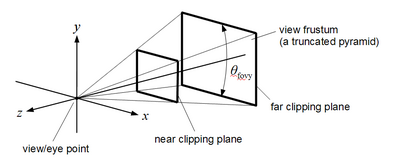The purpose of the 4 parameters is to define a view frustum, like this:

where nothing outside of the frustum should be is visible on screen ( To accomplish this, the parameters are used to calculate a 4x4 matrix, which is then used to transform each vertex into the so-called clip space. There, testing if a vertex is inside the frustum or not is trivial )
The field of view parameter is basically the angle in between a plane passing through the camera position as well as the top of your screen & another plane passing through the camera position and the bottom of your screen. The bigger this angle is, the more you can see of the world - but at the same time, the objects you can see will become smaller.
To observe its influence, I'd suggest coding a simple app where you can gradually increase / decrease the fov via keypress - then render some spheres or other basic objects & see what happens as you change it.
The aspect ratio is your viewport's aspect ratio. ( In the graphic above, the viewport is located at the the near clipping plane ) Being able to define it at will makes sense, since your viewport's aspect ratio may vary.
The zNear & zFar values define the distance between the camera position & the near and far clipping planes, respectively. Nothing that's closer to the camera than zNear or farther away than zFar will be visible. Both values must be > 0, and obviously, zFar > zNear.
zFar should ideally be chosen so that everything you want to render is visible, but making it larger than necessary wastes depth buffer prescision & may lead to flickering effects, called z-fighting. Likewise, setting zNear too close to the camera may cause the same effect - in fact, having a reasonable zNear value is more important than zFar. If you want to know exactly why this happens, you should read some in-depth explanations, like this one or this one
与恶龙缠斗过久,自身亦成为恶龙;凝视深渊过久,深渊将回以凝视…
